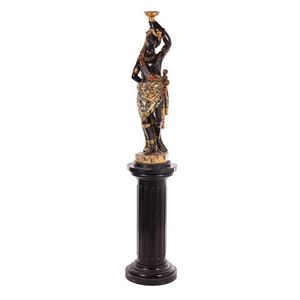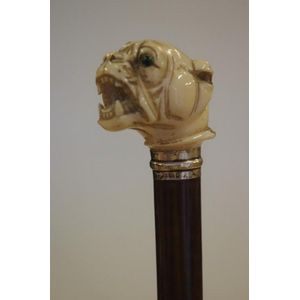Sterling Silver Collared Snakewood Walking Cane, 1924 London Hallmark
You must be a subscriber, and be logged in to view price and dealer details.
Subscribe Now to view actual auction price for this item
When you subscribe, you have the option of setting the currency in which to display prices to $Au, $US, $NZ or Stg.
- Sterling Silver - Sterling silver is a mixture of 92.5% pure silver and 7.5% of another metal, usually copper. Fine silver is 99.9% pure silver, and is relatively soft and the addition of the very small amount of copper gives the metal enough strength and hardness to be worked into jewellery, decorative and household objects.
- Ivory - Ivory is a hard white material that comes from the tusks of elephants, mammoth, walrus and boar, or from the teeth of hippopotamus and whales. The ivory from the African elephant is the most prized source of ivory. Although the mammoth is extinct, tusks are still being unearthed in Russia and offered for sale.
Ivory has been used since the earliest times as a material for sculpture of small items, both in Europe and the east, principally China and Japan.
In Asia ivory has been carved for netsuke, seals, okimono, card cases, fan supports, animals and other figures and even as carved tusks.
In the last 200 years in Europe ivory has been used to carve figures, for elaborate tankards, snuff boxes, cane handles, embroidery and sewing accessories, in jewellery and as inlay on furniture. Its more practical uses include being used for billiard balls, buttons, and a veneers on the top of piano keys.
The use and trade of elephant ivory have become controversial because they have contributed to Due to the decline in elephant populations because of the trade in ivory, the Asian elephant was placed on Appendix One of the Convention on International Trade in Endangered Species (CITES), in 1975, and in January 1990, the African elephant was similarly listed. Under Appendix One, international trade in Asian or African elephant ivory between member countries is forbidden. Unlike trade in elephant tusks, trade in mammoth tusks is legal.
Since the invention of plastics, there have been many attempts to create an artificial ivory
This item has been included into following indexes:
-
walking sticks and canes, material
- ivory or ivory mounted 209
- silver mounted 435
- walking sticks and canes, types - walking canes 319
Visually similar items

Ada Cipriani (Italian b. 1904) An Italian carved marble statue of a child on a turned marble pedestal, 151 cm high overall, the statue 54 cm high

Gilt metal pedestal, with gadrooned top, with a caryatid stem support on a scroll base. 107 cm high

A Venetian gilt and polychrome blackamoor figural torchere on base, 19th century, the male figure wearing a turban and drapery over shoulder and waist, standing in contrapposto with right leg forward and right hand behind, holding a horn in his raised left

A pair of bronze Infant seat Nymphs on marble pedestals, each figure holding a conch shell, the green marble pedestals of ionic form, 163 cm total height
